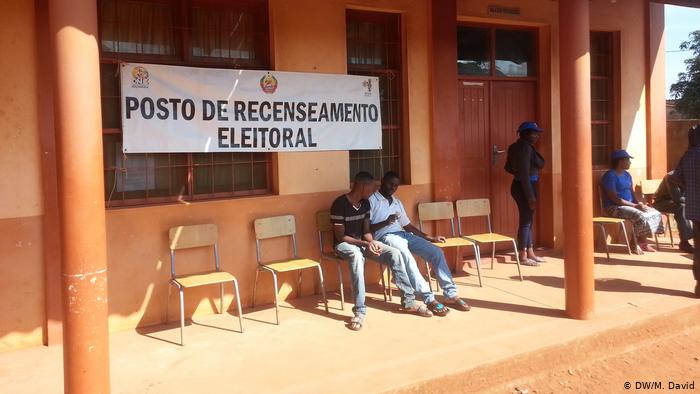Mozambique: President Chapo expected to visit Angola this week, meet businesspeople in Luanda on ...
Mozambique: INE insists its statistics are reliable – AIM report

File photo: DW
The statistics produced by Mozambique’s National Statistics Institute (INE) “are reliable and should be used by society”, declared the INE’s National Director for Censuses and Surveys, Arao Balate, at a Maputo press conference on Wednesday.
The INE has come under attack from certain propagandists in Mozambican social media because its population statistics clearly show that the National Elections Commission (CNE) and its executive body, the Electoral Administration Technical Secretariat (STAE), have wildly exaggerated the number of people of voting age (18 years and above) in the southern province of Gaza.
STAE set a target for voter registration in Gaza of 1.14 million, and the final number of voters supposedly registered in the province was 1,166,011.
But this is much higher than the number of adults of voting age (18 and above) found in the province by the National Statistics Institute (INE) during the population census of 2017. The census counted the number of people in Gaza at 1,422,460. At a population growth rate in the province of 1.2 per cent, the projected size of the Gaza population in 2019 is 1,456,599.
The INE says that, of this figure, 836,581 people are aged 18 and above (57.4 per cent of the total), and are thus entitled to register as voters. But the CNE/STAE figure is larger by almost 330,000.
One of the objections to the 2017 census was that it omitted some of the population. This is perfectly true, since no census ever manages to count 100 per cent of the people living in a given territory. But after each of the four population censuses held in Mozambique, a coverage survey has been held to estimate how many people were left out.
The census was held in August 2017, and the coverage survey the following month. Balate said the survey discovered a national omission rate of 3.8 per cent. The omission rate was highest in the thinly populated northern province of Niassa. In Gaza the omission rate was only 2.5 per cent.
Using standard international statistical methodologies, the definitive population statistics announced by INE in April this year took the omission rate into account.
Balate said he had no idea how the CNE and STAE had reached figures for the Gaza population so at variance with the census. “We can’t explain Gaza – it’s beyond all demographic theories”, he added.
Based on the census, the INE has now made projections for the population of each province up until 2050. Balate said that, according to these projections, the number of people aged 18 and above in Gaza will only reach the figure claimed by CNE/STAE in 2040.
One of those denouncing STAE on Facebook had claimed that the INE was “lying” because the INE gave 25 May as the date on which it had delivered the definitive date for adults of voting age to STAE. 25 May was a Saturday, and government offices are not open on Saturdays, hence the INE must be lying, went the argument.
Balate explained that he had tried to contact the national director of STAE, Felisberto Naife, on Friday, 24 May, but had been unable to speak to him then. It was only on the following day that he managed to give STAE the figures.
Furthermore, the initial estimates for the population of voting age were available in February and March, well before the voter registration began on 15 April. “We had the number of people who were aged 16 in 2017, and sat down with STAE and gave them the figures”, Balate said.
The INE was not hiding anything, he added, and he did not know what methodology STAE had used to reach its figures.
Balate told AIM after the press conference that none of the people writing material hostile to the INE on social media, and even in the Maputo daily “Noticias”, had ever bothered to contact the INE.
Balate also announced that the INE is now preparing the next Household Budget Survey (IOF), which is a fundamental instrument for assessing levels of poverty in Mozambique. The survey will start in November, and will take 12 months. Only in 2021 will the results be published “and then we will update the poverty line”.
The sample for the IOF will be 13,570 households, representative of both urban and rural areas and of all the provinces. This is considerably larger than the samples used in previous IOF surveys – 11,628 households in the 21014-15 IOF, 10,848 in the 2008-09 edition, and 8,727 in 2002-03.
The data will be collected by 24 brigades, each of six members. Five million US dollars has been pledged by the World Bank for this survey.
These surveys found that the number of Mozambicans living in poverty was over two thirds of the population (69.4 per cent) in 1996-97, but dropped sharply to 54.3 per cent in the 2002-03 IOF. There was a slight deterioration in the 2008-09 survey, which put the number of people in poverty at 54.7 per cent. The downward trend then resumed, with the 2014-15 IOF classifying 49.2 per cent of the population as poor.
“Em termos científicos, ultrapassa todas as teorias demográficas. Não se pode perguntar isso ao INE o que aconteceu porque nós não sabemos…”
Estou ainda à espera do CNE pic.twitter.com/4mCrHc2Uwf
— Bayano Valy ?? (@BayanoValy) July 17, 2019













Leave a Reply
Be the First to Comment!
You must be logged in to post a comment.
You must be logged in to post a comment.